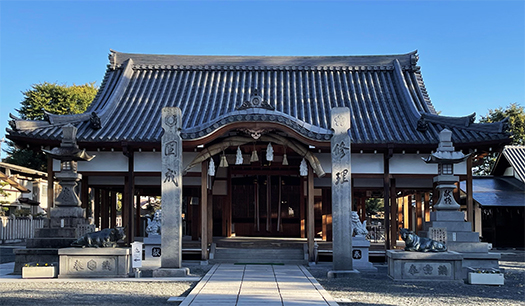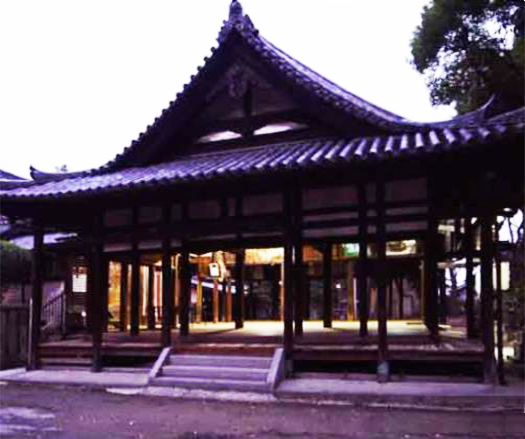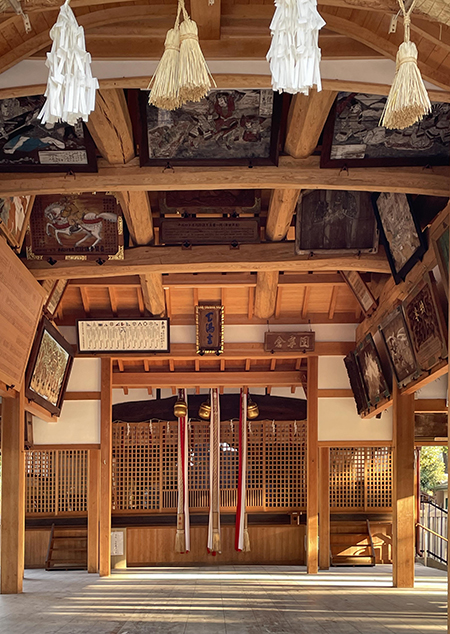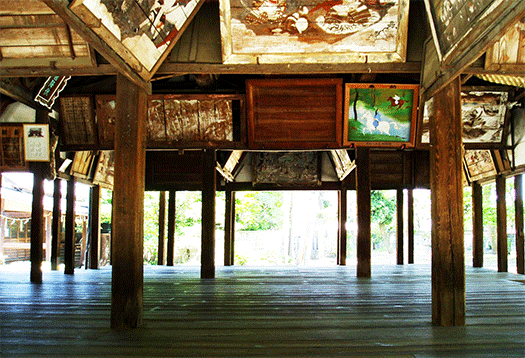

本日深夜から早朝にかけて、札幌初雪であります。何回迎えても好きな静寂感。北国人はそれまでの日常感からは相当に違った感覚で、この初雪と「再会」する。今年の初雪はどれくらい降るのか。
別に雪に「音」の要素はないように思われるでしょうが、ヘンな言い方ですが降ってくる初雪には「静寂」という音楽性を感じるのですね。って、実際にも雪には「遮音性」があるかも知れません。空気の「反響」要素でそれを低下させるような因子を雪は持っているのかも知れない。・・・
さて、コロナ禍を超えてのご縁のある姫路市の「英賀神社」再訪。令和の大修理工事が完了してはじめての参拝をさせていただけた。家系の伝承というものもあるのですが、そういうこと以上に強く惹き付けられていたのがこの「拝殿」建築の空気感なのであります。上の写真が今回の修理後で、下は2015年訪問時の旧殿舎の様子。
わたしは遭遇したことはありませんが、こちらの英賀神社拝殿は祭礼の神輿が進入するという文化があるとされている。大人数が一挙に上がるので床面の強度は経年劣化を危惧される。そういうことで今回も建て替えの動機になったそうですが、そういう民の「躍動感」を強く感じる。今回の大修理でたくさんの人数が一度に乗っかっても大丈夫なように土台部分が強化されたという。
北海道の初雪は静寂の音楽性だとすれば、こちらの音楽性とはまさに民の躍動ではないだろうか。
繰り返しこの神社境内を訪れる気持ちの中に、この「民衆性」への共感があると思っている。こういう民衆性を象徴しているのがこの「拝殿建築」なのでしょう。わたしの妄想なんですが、この英賀の地は浄土真宗の一大根拠地であったとされている。戦国期には勃興してきた中央政権勢力・織田氏へのレジスタンス活動を行ってきた。この拝殿は、そういう反織田の「決起集会」の空気感を感じる(笑)。
学生時代、アジ演説を絶叫してのそういう集会によく参加していたけれど、不思議にそういう同一空間性を感じるのですね。理性的整合性ではなく、肌感覚の部分でしょうか。
そういうのが好きな自分を再発見させられる結界のような空気感があるのでしょうか。


そういう雰囲気がわかりやすく展開しているのが、この拝殿にたくさん奉納された「掲額」の集合展示。写真は上が今回の修理後で、下は2015年訪問時の旧殿舎の様子。民が歴年、神社に対して奉納し続けた掲額のキッチュでわかりやすい日本人的な心象を掻き立てられる伝統的絵画画面が、まるで群舞のように舞い踊っているような感覚がある。
言ってみれば播州の民のパワーが圧倒的に迫ってくるように思える。
いろいろな「空間性」を感受し続けてきて、ひとつの典型例のようにこの拝殿と掲額には惹き付けられ続けているのであります。自分でもオカシイのですが(笑)。
English version⬇
Reunited with my favorite Eiga Shrine “worship hall” and “plaque”.
The musicality of the dynamism of the people felt in the architecture. On the other hand, the musicality of the silence of the first snowfall that people in northern Japan feel. I was embraced by these two contradictory atmospheres. The first snowfall
It is the first snow in Sapporo from midnight to early morning today. It is a feeling of tranquility that I like no matter how many times I welcome it. Northerners “reunite” with this first snowfall with a feeling that is quite different from the everyday feeling they had before. How much will this year’s first snowfall be?
You may think that snow has no “sound” element, but in a strange way, I feel the musicality of “silence” when the first snow falls. In fact, snow may have a “sound insulation” property. Snow may have a factor that decreases it with the “reverberating” element of air. …
Now, we revisit “Eiga Shrine” in Himeji City, with which we have a connection beyond the Corona disaster. I was able to visit the shrine for the first time since the completion of the major repair work in 2025. Although there is a family tradition, what attracted me more strongly than that was the atmosphere of the “worship hall” architecture. The photo above is after the current repairs, and below is a view of the old hall when I visited in 2015.
Although I have never encountered it, this Eiga Shrine worship hall is believed to have a culture in which the portable shrines of festivals enter the building. Since a large number of people go up at once, the strength of the floor surface is feared to deteriorate over time. That is what motivated the rebuilding this time as well, and I strongly feel the “dynamism” of such people. The foundation has been strengthened so that it can withstand a large number of people on it at once during this major repair.
If the first snowfall in Hokkaido is the musicality of silence, the musicality of this shrine is the dynamism of the people.
I believe that the sympathy for this “populace” is one of the reasons why I repeatedly visit the shrine grounds. The architecture of the worship hall symbolizes this “populace. It is my imagination, but it is said that this Eiga area was one of the major grounds of the Jodo Shinshu sect. During the Warring States period, the Jodo Shinshu had been active in resistance against the rising central government power, the Oda clan. This worship hall has the air of such an anti-Oda “rally” (laughs).
When I was a student, I often participated in such rallies, shouting out agi speeches, but strangely enough, I feel that kind of identical spatiality. I guess it is not a matter of rational consistency, but of a sense of the skin.
Is there an atmosphere like a boundary that makes me rediscover my love for such things?
Such an atmosphere is clearly developed in the collective display of the many “hoist plaques” dedicated to this hall of worship. The photo above shows the shrine after the recent repairs, and below is a view of the old hall at the time of our visit in 2015. The kitschy, easy-to-understand traditional paintings that stir the Japanese mind are like a group dance.
In other words, the power of the people of Banshu seems to overwhelm the viewer.
I have been attracted to this hall of worship and the plaque as a typical example of the various kinds of “spatiality” that I have been perceiving. It is funny even for me (laugh).
Posted on 11月 11th, 2023 by 三木 奎吾
Filed under: 住宅取材&ウラ話, 日本社会・文化研究







コメントを投稿
「※誹謗中傷や、悪意のある書き込み、営利目的などのコメントを防ぐために、投稿された全てのコメントは一時的に保留されますのでご了承ください。」
You must be logged in to post a comment.